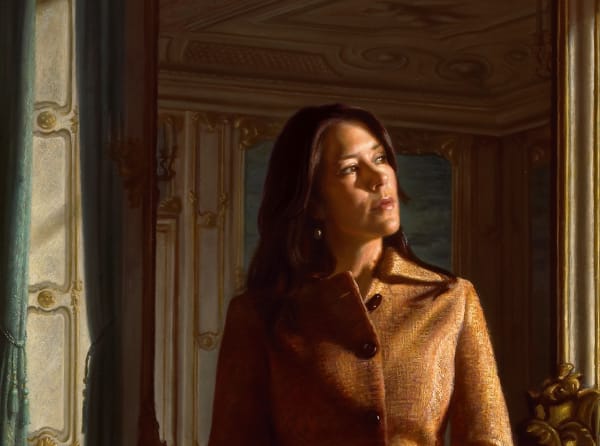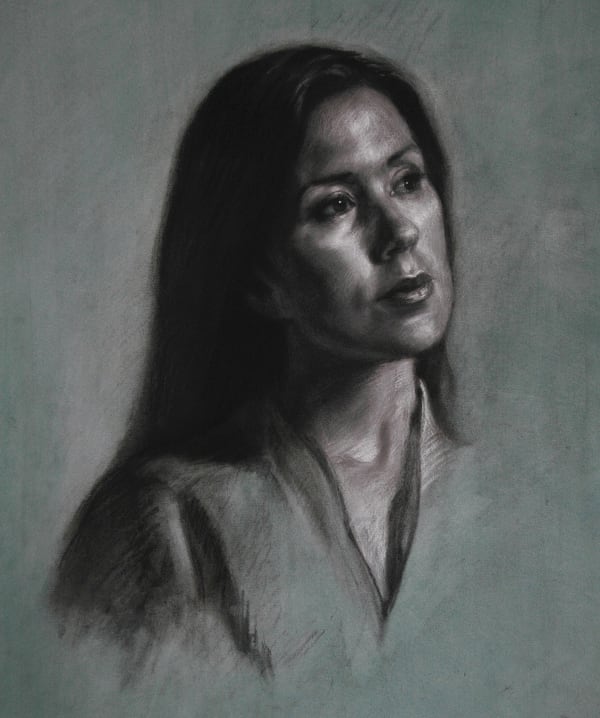-

-
Video
-
Portrait of a Crown Princess
By Mette SkougaardIn 2005 The Museum of National History at Frederiksborg decided to commission a portrait of the new Crown Princess, the Australian born Mary Elizabeth Donaldson. For the commission of the portrait, the museum made no restrictions as to the size or composition of the work. It was, however, made clear from the outset that the painting did not need to be official in character but, rather, present a more personal study of the Princess, acknowledging her Australian background and her role in the present day Danish monarchy. This idea appealed to Heimans, who, immediately after taking on the commission, started to acquaint himself with Danish history and art whilst researching the role of the monarchy in contemporary society.
Work on the portrait began in May 2005, when Heimans visited Denmark and was introduced to the Frederiksborg Castle and the Museum of National History. He met the Crown Princess on several occasions, taking photographs and producing sketches during a lengthy sitting. He also had the opportunity to visit a number of rooms at Fredensborg Palace, which led to his decision to depict the Crown Princess in the famous Garden Room. This beautiful 18th century rococo interior – a room par excellence for representing Danish royalty – was most famously used as the setting for Laurits Tuxen’s Christian IX and Queen Louise with Family in the Garden room (1882-83). Moreover, this is also the room in which the then Miss Mary Donaldson was presented to the public on the occasion of her engagement to the Danish Crown Prince in October 2003. Here, within an architectural setting that embodies the history of the Danish monarchy, the artist found the ideal context in which to symbolize the Princess’ path from that of a young Australian fiancee to her present role as the Danish Crown Princess and future Queen. Heimans revisited Fredensborg and the Crown Princess in September 2005 and January 2006 in order to make further studies, and since then the work progressed in his studio in Paris.
In the painting the Crown Princess is shown almost full figure in the Garden Room, standing elegantly dressed in a modern suit, but without obvious signs of her status. A soft golden light streams into the room from the windows in the right side of the painting, towards which she is looking. She stands in front of a sofa, with chairs around her, seen in a moment where she is putting on a pair of gloves, as if about to leave the palace. A coat at the ready lies over the back of the chair in front of her. The mirror behind her reflects her figure whilst providing a deeper perspective into the interior of the Garden Room.
At first impression the room seems very true to life – the furniture with its gilt rococo ornaments and silk covers meticulously rendered in detail, is immediately recognisable as the Garden Room at Fredensborg. On closer inspection, however, the room is redolent with subtle incongruities and alterations. The most evident change is the substitution of a large mirror for Jacopo Fabris’ landscape with Roman ruins (1750-51). Reflected in the mirror, on the back wall of the Garden Room, Fabris’ paintings have been replaced by a view of historic buildings from Consitution Dock in Hobart.
The inclusion of the mirror provides a window into a new visual dimension and becomes an artistic device intended to represent the two worlds of the Crown Princess: her present day life as a member of the Danish Royal Family and her earlier life in Australia. In the foreground, the depiction of the Crown Princess preparing to leave the palace alludes to her present life, duties and obligations. Here she is depicted in a moment of thought as she is about to undertake her public duties and the viewer is prompted to imagine what she may be thinking as she is about to move from her private to her public realm. In the background, the reflected mirror image reminds the viewer of her Australian past, represented by a view of the city of her birth. In this way the metaphor of leaving represents the moment of transition between these two worlds of private and public life, and the bridge between the past and the present.
Heimans’ portrait draws upon the pictorial tradition of royal portraiture whilst at the same time playfully infusing the tradition with new ideas and meaning. Rather than representing a formal and official image of the Crown Princess, the portrait departs from tradition by portraying her in an informal and everyday action, using a narrative approach to express the story of her life. The use of gloves, for example, a common symbol of status found in traditional Royal portraits such as Holbein’s portrait of Princess Christina of Denmark (1538), here becomes an integral part of the portrait’s narrative and a metaphor for the moving between two worlds. In this way, the narrative contributes to a far more accessible vision of the crown princess, as though the viewer is allowed a glimpse into her real world: she becomes more than a mere symbolic public figure, but a person the viewer can empathize with.
The result is a poignant and personal portrait of a princess that prompts us to reflect upon the evolving role of royalty in the modern world.







